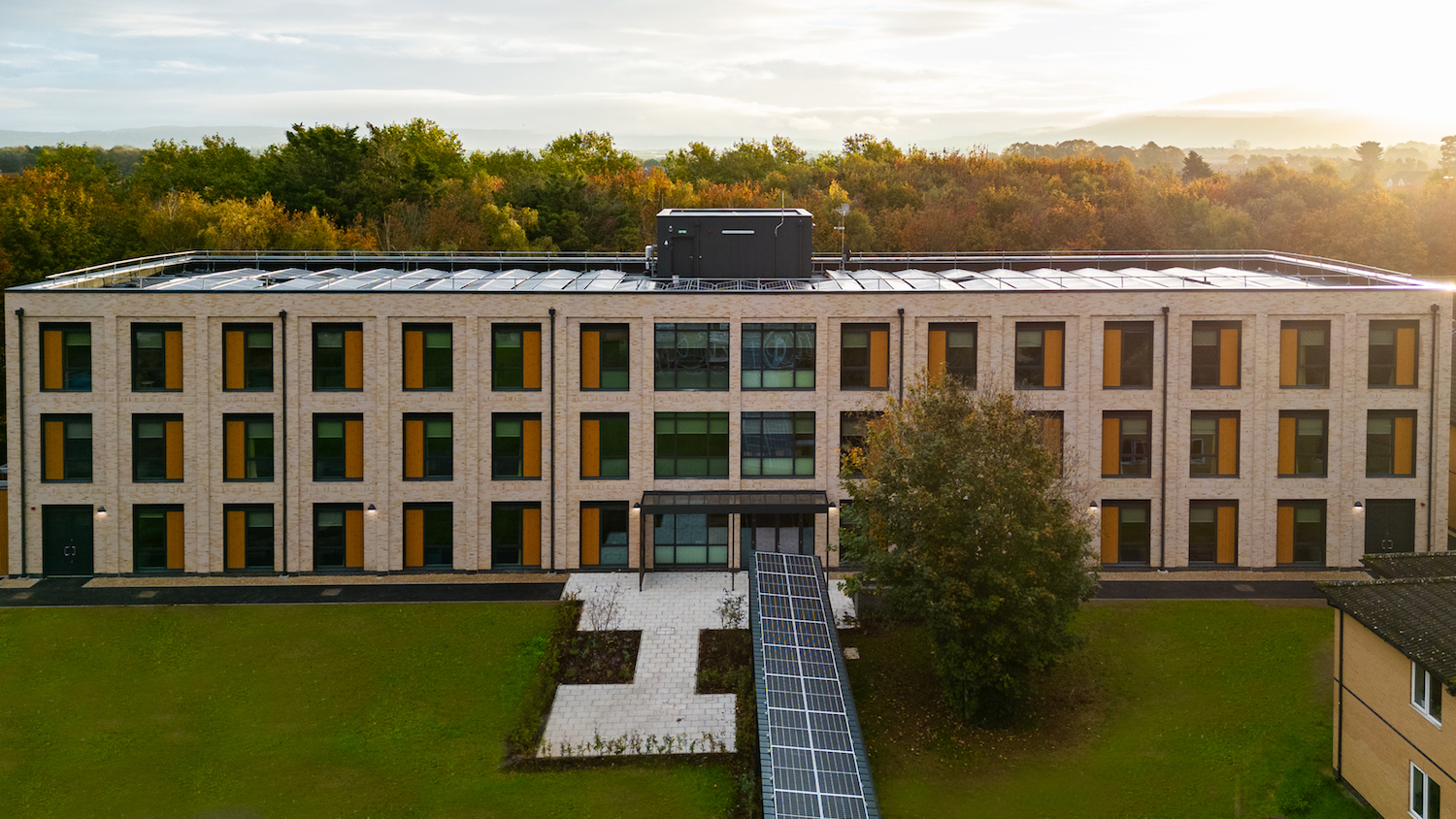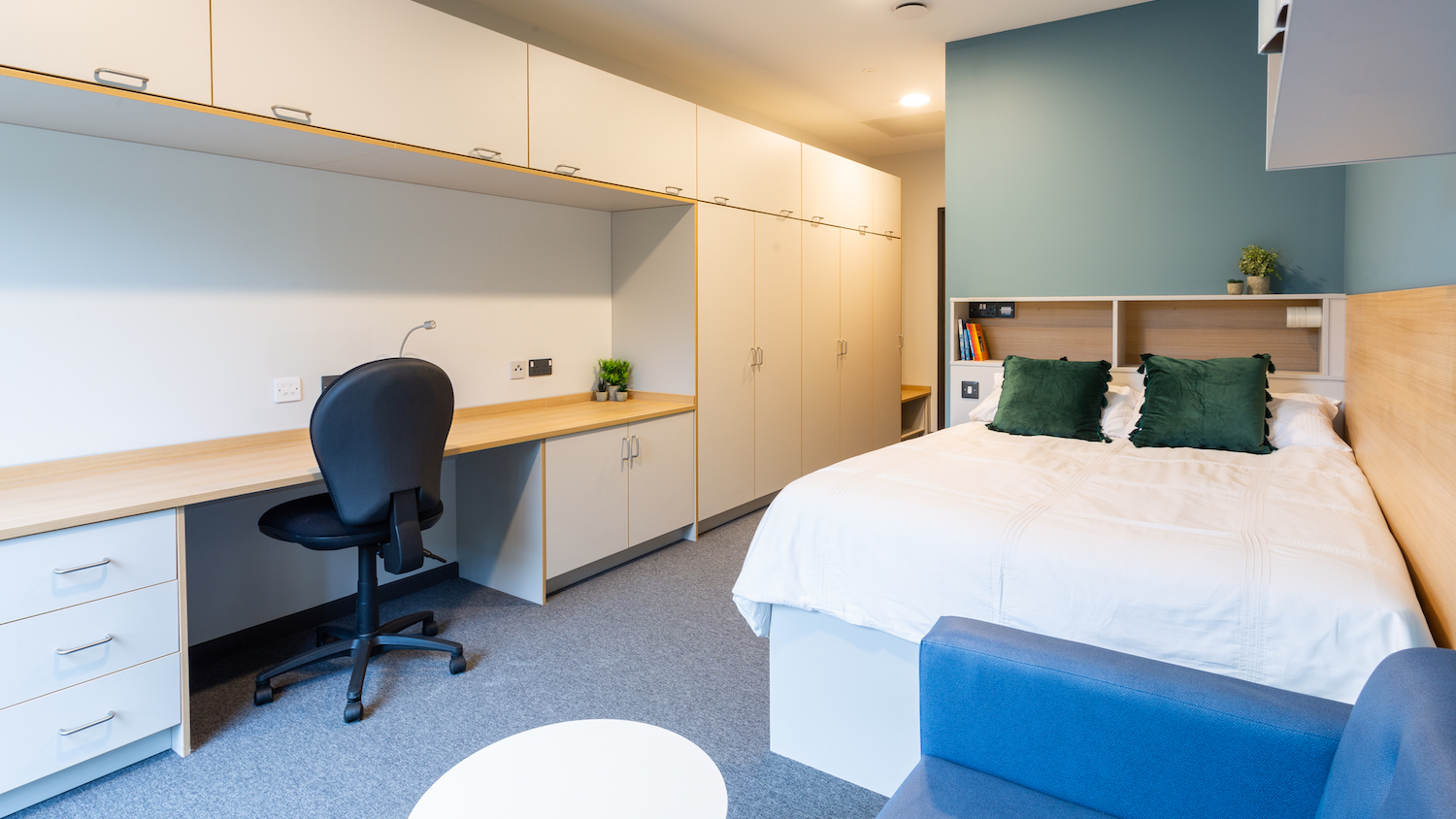
The Army is aiming to hit its environmental targets with the help of a modular three-storey accommodation block brimming with smart technology and sensors.
A pioneering new smart barracks that sets low-carbon standards for single living accommodation for army personnel has been completed at Imjin Barracks in Gloucestershire. The £13m project is the first of a new wave of sustainable construction for the Army and is one of the most advanced buildings in Europe for smart building control.
The three-storey building has been delivered for the Army by the Defence Infrastructure Organisation, contracting to vertically integrated offsite construction specialist Reds10. The building is fitted with hundreds of sensors that will help reduce energy in use. The sensors will also provide feedback on the building’s performance that will be used to hone the design of future buildings.
Paul Ruddick, chairman and founder of Reds10, says: “The Ministry of Defence (MoD) has been very forward thinking and what they are trying to achieve for the building is very much ahead of the curve. They realised that investing in smart technology will save them money in future energy bills.”
Since mid-2022, Reds10 has been delivering £150m of government construction work across a variety of departments. As well as working for the MoD, it’s also involved with the Department for Education and the Ministry of Justice, recently constructing seven new modular schools and up to 1,000 new temporary prison cells.
Reds10’s factory in East Yorkshire can manufacture up to 1,200 units a year. When the modular units reach site, they are more than 90% completed, explains Ruddick.

“The MoD has been very forward thinking and what they are trying to achieve for the building is very much ahead of the curve.”
£1.4bn programme
The new Imjin Barracks single living accommodation was completed at the end of 2023 after a 14-month programme, which also included landscaping, an access road and covered walkways.
It is the first block to be built in the Army’s £1.4bn Single Living Accommodation (SLA) Programme, which will provide 8,500 SLA bed spaces over 10 years to improve living conditions for serving personnel. Additionally, 8,000 SLA bed spaces are being provided by the Defence Estate Optimisation Army Programme.
The new three-storey building at the Imjin Barracks provides modern, high-quality and sustainable accommodation for army personnel based at the HQ of the Allied Rapid Reaction Corps. The building has 69 single en suite bedrooms, alongside communal facilities.
Ruddick says other public sector projects they have been involved with have smart technology, but this is by far the most advanced.
Reds10’s proprietary smart building system has been built into the units, which generates and analyses more than 21,000 data points (including humidity, door and window contacts, sound levels, temperature, daylight, power metering, water and more). A typical Class A Building Management System has around 220 data points feeding into it.
The value of real-time data
Ruddick explains that large volumes of real-time data are processed and accessed via a platform powered by Reds10’s SMART building technology, Thrive, which optimises operational performance and maintenance.
“We design everything ourselves in-house and install as a system that allows all the hardware to talk to each other.”
Sustainability measures include photovoltaic panels (PVs) and air source heat pumps to provide heating and hot water. The PVs are coupled to a Nano Crystal cell battery that can store up to 1,327kWh of energy. It is anticipated that during the summer months energy generated by the PVs during the day will be stored by the battery. This energy will then be harnessed for heating hot water at night, so that the building can operate entirely off grid.
“It’s not quite net zero – but we have an EPC rating of 2 and it’s encouraging that with just a few more PVs added to the building, we would be net zero in operation,” says Ruddick.
The modules are manufactured from lightweight steel frame and highly insulated internal timber stud walls. This design, coupled with a highly efficient mechanical and electrical system, produces low air-tightness and energy-use intensity.
The accommodation block meets impressive environmental targets. Reds10 says that it has achieved a Defence Related Environmental Assessment Methodology ‘Excellent’ rating, has scored more than 95% on the Smart Readiness Indicator, and complies with a BACS Class A building (BS EN ISO 52120).
Customising heat preferences
Each bedroom is equipped with a programmable touchscreen that allows the occupant to customise their heating preferences, increase ventilation and identify any issues. Moreover, the touchscreen provides tenants with information on their monthly electricity and heating consumption, which is ranked on a building-wide leaderboard. Reds10 says the use of gamification strategies helps to incentivise and motivate occupants to make conscious sustainable changes in their everyday lives.

“What is really interesting about the building is that we’re actually going to see how the building performs, which rarely happens on projects, so we can make sure we’re optimising design on the future buildings on the SLA Programme as well,” Ruddick explains. One example he cites is to optimise the size of the battery needed for future buildings.
Ruddick says that having an integrated business model plays to the installation of smart systems. “Generally in buildings, a number of systems are installed that don’t talk to each other. But we design everything ourselves in-house and install as a system that allows all the hardware, like the air-source heat pumps and mechanical ventilation and heat recovery systems, to talk to each other.
“And then we overlay that with the code so it responds to an occupant’s behaviour. When someone is in the bedroom, for example, and they open the window, it turns off all the heating in that bedroom. That’s one of the reasons why it’s low energy usage. If there is an unseasonably hot day in October, the system automatically turns the heating off.”
How to succeed in modular
Reds10 worked with HLM Architects and Arcadis on the project. It is now working on single living accommodation for barracks in Berkshire, Wiltshire and Oxfordshire.
Ruddick founded Reds10 in 2006. While other manufacturers have hit the buffers of late – including high-profile names such as Ilke Homes and Legal & General Modular Homes – Ruddick says the business is thriving with a bulging order book and each one of its five production lines full with orders.
“We’re a market leader terms of the level of quality of modular buildings we build. So we have proven, offsite can work and deliver a high quality building,“ he says.
Reds10 has adopted a different business model to rivals and has eschewed residential, where the stop-start nature of the market is often at odds with keeping a production line in a steady flow of work. Instead, it focuses on public infrastructure. “The volumetric model can work well, but those that have been forced to close were just in the wrong market,” Ruddick observes.
Don’t miss out on BIM and digital construction news: sign up to receive the BIMplus newsletter.














